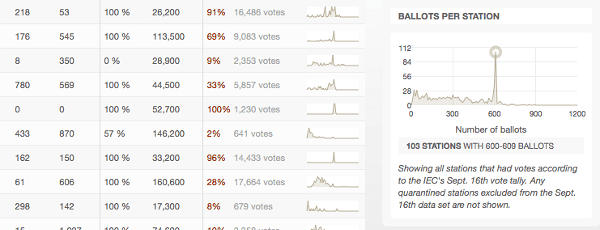Mapping Afghanistan Election Data
 Part of the long process of opening data - ballot boxes are loaded into an Mi-17 helicopter, Jaghuri, Afghanistan. (ISAF photo by U.S. Air Force Staff Sgt. Joseph Swafford)
Part of the long process of opening data - ballot boxes are loaded into an Mi-17 helicopter, Jaghuri, Afghanistan. (ISAF photo by U.S. Air Force Staff Sgt. Joseph Swafford)
Opening Afghanistan's Election Data
As Afghanistan tries to rebuild as a democracy, its past two elections have been complicated by security incidents and marred by voter fraud. To help visualize the situation we partnered with the National Democratic Institute (NDI) on the ground in Afghanistan for the international election observations during both the 2009 presidential elections and the 2010 provincial council election.
Built for On the Ground Operations

These custom data browsers allowed NDI to explore detailed and complex data related to the elections. While all of the data visualized on these sites is from public data sets, the data was originally released in PDF format. Baked as a PDF, the data was rigid and this really handicapped analysis by election monitors. It was impossible to read it and quickly make sense of the data, and the static format made it hard to run any equations on the data to help draw conclusions about the election results.

The site allows users to browse the raw vote count on a national view and quickly drill down to a provincial, district, and even polling center view - showing the number of votes all the way down to the ballot box. Users can run custom queries to see the number of votes per voting station and the percentage for a single candidate, and see the results on custom maps of Afghanistan that have additional data overlays like ethnic and security data. All of these voting trends are then graphed down to the polling center level.

Building Capacity for Fair Elections
These applications were first designed as internal tools to help NDI's geographically dispersed teams monitor the elections as the results came in. After the election results were finalized, the data browsers were opened to the public to provide data that can be used by other NGOs and CSOs looking to build better capacity and to improve future elections. Making the data and these applications publicly accessible also helps key stakeholders in the Afghan political process – including government officials, political parties and domestic monitoring groups, and members of the international community.
Have a challenging project that could use our help?
Let's connect
We'd love to hear from you.